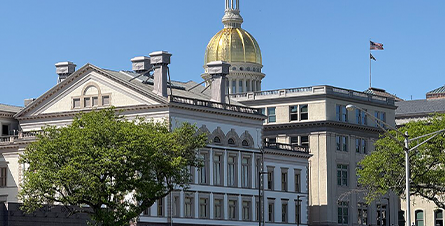PFAS Payback: How utilities can hold polluters accountable
5.22.23
As water systems across the country prepare for the newly proposed EPA PFAS drinking water regulations to take effect, many are wondering how their budgets will accommodate the significant costs of treating water for these chemicals. On March 14th, 2023, the U.S. EPA proposed new Maximum Contaminant Levels (MCLs) for PFAS, including new limits for perfluorooctanoic acid (PFOA) and perfluorooctane sulfonic acid (PFOS) at 4 parts per trillion (ppt). The cost of managing PFAS pollution, which may include shutting down contaminated water sources, purchasing water from other jurisdictions, and building and operating new treatment facilities, can be in the millions of dollars.
Hundreds of water systems affected by PFAS across the U.S. have decided to pursue litigation against PFAS manufacturers to recover their anticipated treatment costs. These cases have been grouped together before the same court in what is known as a multidistrict litigation (MDL). The trial for the first of these water system cases is scheduled to start June 5, 2023.
Below, SL attorney Ken Sansone answers some common questions water systems might have about how the MDL may be able to help with the cost of compliance with the new EPA proposed MCLs.
Common PFAS Contamination Questions Answered by an Experienced Water Contamination Attorney
How does multidistrict litigation work in the context of PFAS lawsuits?
An MDL is a consolidation of many lawsuits from around the country involving similar claims by different plaintiffs against the same defendants. The whole purpose of the MDL is to consolidate the beginning stages of litigation while reserving each plaintiff’s right to take its own case to trial, with lawyers of its own choosing. Although MDLs often result in what are called “global settlements” of the claims brought by most or all of the plaintiffs, it’s always up to each individual plaintiff whether to enter into a settlement. If the plaintiff is not happy with what’s being offered, it will have the chance to take its case out of the MDL, to federal court in its home state, and bring the case to trial there.
As many municipalities and other water utilities across the U.S. filed lawsuits claiming that their water supplies have been contaminated with PFAS from aqueous film-forming foam (AFFF), either alone or in combination with other PFAS-containing products, they have had their cases grouped together before the same court in an MDL. The MDL was formed in December 2018 and is being heard in the U.S. District Court for the District of South Carolina. There are four categories of plaintiffs: water providers, property owners, personal injury plaintiffs, and the sovereigns (states, territories, and tribes). The water provider cases are one subset of approximately 2,500-plus cases pending in the MDL, but the court has selected the water provider cases to go first.
While the costs for cleaning up PFAS can be high, taking legal action doesn’t have to cost money up front.
Why is this necessary and helpful for utilities?
An MDL generally has a lot of advantages:
- If early cases in the MDL are resolved in favor of the plaintiffs, it often results in a domino effect of settlements for the remaining cases, which can be resolved without requiring lengthy discovery and pretrial litigation processes. In fact, water providers that file in the MDL now are not subject to depositions or other burdensome discovery demands but need only to complete a brief “fact sheet” that summarizes their PFAS impacts. Typically, the presiding judge tries to steer the parties toward an agreeable resolution with a national settlement. Unlike a class action settlement, an MDL settlement is not binding on any party without its agreement to participate; if a case is not settled during an MDL, it is sent back to the plaintiff’s home court for trial.
- Of the water systems involved in the MDL, three bellwethers were chosen as test cases. Bellwether trials are used to work through common legal and factual issues that apply to the majority of the other similarly situated cases. If the test cases receive favorable results, the larger pool of plaintiffs can proceed more efficiently, often creating a domino effect of settlements or court judgments.
- Given the progress that has already been made, this MDL may provide water providers their best chance of recovering the costs of PFAS cleanup, and doing so quickly. There is still time to file a claim and join this MDL. It is a streamlined legal process, and if water providers choose a law firm that works on contingency, fees are only paid if their case receives a successful outcome.
The public’s understanding of the dangers and prevalence of PFAS is expanding as the mainstream media continues to ramp up coverage. Organizations suing these polluters are demonstrating to the public a responsible approach for covering the costs associated with the cleanup rather than asking their ratepayers to foot the bill.
What does it mean for the utility’s customers?
If the water systems are able to recover the cleanup costs through litigation, they will not be forced to raise their rates to build and run the water treatment plants. As a result, their ratepayers (i.e., the public) won’t have to shoulder the burden caused by the PFAS polluters.
How are liability and the share of culpability determined?
Almost all PFAS compounds entered the environment due to the actions of a small group of manufacturers, led by 3M and DuPont. In fact, 3M was the only manufacturer of PFOS in the United States and the principal manufacturer of PFOA as well (until DuPont began making PFOA in the early 2000s). Though these manufacturers supplied PFAS compounds to other smaller manufacturers that incorporated them into other products, many of them did so without knowing the risks of releasing PFAS into the environment. As a result, 3M and DuPont have been named as the defendants in virtually all lawsuits over PFAS contamination filed by water suppliers, which have not typically named local businesses that used or released PFAS.
How can utilities get involved in multidistrict litigation, what would be required of them, and are there specific timelines to adhere to?
- Additional plaintiffs can still join the MDL, which is likely one of the faster routes for a utility to try to obtain compensation if it has been impacted by PFAS from AFFF. Proceedings in the MDL have been underway for water providers for three years, so plaintiffs who join now effectively get the benefit of that earlier work and face a shorter time until potential resolution of their cases.
- While the costs for cleaning up PFAS can be high, taking legal action doesn’t have to cost money up front. Some law firms, including SL Environmental Law Group, work on a contingency basis — meaning that the firms advance the costs of litigation and are paid only if there is a successful outcome.
- In order to file a lawsuit as part of the AFFF MDL, water systems should hire a law firm experienced in handling these kinds of cases, which will be able to draft a complaint to get the lawsuit filed. Because just a small group of manufacturers are responsible for PFAS, a lengthy investigation is typically not necessary before filing the case.
- The statute of limitations is a time limit that applies to every legal claim. Outside of special circumstances, claims brought after the statute of limitations has run out cannot be brought to court, no matter how valid or valuable they are. The time to bring a lawsuit varies from state to state, but can be as short as two years, and what triggers the clock can also vary from state to state. Water providers that have detected PFAS in their supplies, at any level, should consult with experienced legal counsel at the first opportunity to evaluate the potential impact of the statute of limitations on their PFAS claims.
- Better yet, water providers can simply file a claim promptly to avoid or at least minimize any statute of limitations problems — even if their pollutant detections are below the MCL and they do not anticipate any PFAS remediation costs. This protects the system in the event that the MCLs for PFAS change (as they are likely to do, following the EPA’s recent announcement of new draft MCLs for several PFAS compounds) or the levels of PFAS in the system’s supplies increase.
Ready to Take Action?
Water providers with PFAS concerns may want to consider reaching out to a law firm with experience in water contamination litigation. Since there is no upfront cost to retain a law firm that works on contingency, there is no financial risk in taking immediate action. The team at SL Environmental Law Group has over 20 years of experience handling exclusively water contamination cases, and we are ready to help you understand the options available for your unique challenges. To learn more, schedule a free consultation with the SL PFAS team.
Note: This article was originally published in Water Innovations & Water Online. Read the original article here.



